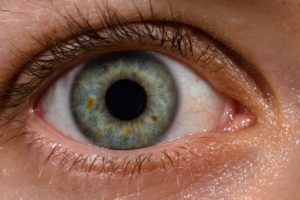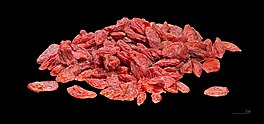
 Again, more benefits of vitamin D. Think of it as the sunshine vitamin, but supplements also work, especially vitamin D3 (rather than D2). This time higher levels of vitamin D in the blood (as measured by the vitamin D biomarker, 25-hydroxyvitamin D [25(OH)D) are linked to lower incidence of macular degeneration among those women genetically prone to it.
Again, more benefits of vitamin D. Think of it as the sunshine vitamin, but supplements also work, especially vitamin D3 (rather than D2). This time higher levels of vitamin D in the blood (as measured by the vitamin D biomarker, 25-hydroxyvitamin D [25(OH)D) are linked to lower incidence of macular degeneration among those women genetically prone to it.
Macular degeneration is thought to have both genetic (inherited) and environmental components. Currently macular degeneration is the leading cause of vision loss and affects about 2.07 million Americans (this is according to the National Eye Institute). Note that this number is very different than that given by the American Macular Degeneration Foundation in the article. From Medical Xpress:
Vitamin D may play key role in preventing macular degeneration
Vitamin D has been studied extensively in relation to bone health as well as cancer. Now, a team led by a researcher at the University at Buffalo has discovered that vitamin D may play a significant role in eye health, specifically in the possible prevention of age-related macular degeneration, or AMD, among women who are more genetically prone to developing the sight-damaging disease.
In a paper published today (Aug. 27) in JAMA Ophthalmology online, Amy Millen, associate professor of epidemiology and environmental health in UB's School of Public Health and Health Professions, and her team found that women who are deficient in vitamin D and have a specific high-risk genotype are 6.7 times more likely to develop AMD than women with sufficient vitamin D status and no high risk genotype.
Macular degeneration is characterized by the deterioration of the macula, a small part of the central retina where the eye's photoreceptors (rods and cones) are most highly concentrated. The leading cause of legal blindness, macular degeneration affects more than 10 million Americans—more than cataracts and glaucoma combined—according to the American Macular Degeneration Foundation. The disease affects a person's central vision, which is needed for common tasks such as reading and driving. The effect is similar to that of a rain drop on the center of a camera lens.
Researchers analyzed data compiled on 1,230 women ages 54 to 74 who participated in the Carotenoids in Age-related Eye Disease Study (CAREDS),..... CAREDS was conducted among participants at three of the centers: University of Wisconsin (Madison), the University of Iowa (Iowa City) and the Kaiser Center for Health Research (Portland, Oregon). Researchers were able to determine participants' vitamin D status by analyzing serum samples for a vitamin D biomarker, 25-hydroxyvitamin D [25(OH)D], which provided a glimpse into vitamin D intake through all sources: diet, supplements and sunlight.
Human skin can synthesize vitamin D when exposed to ultraviolet light, Millen explains. However, for many people, 15 to 30 minutes a day with 10 percent of their skin exposed might be sufficient. In winter months, when there is a lower solar angle, sun exposure may not be not sufficient to maintain blood level for people who live north of a line from about Washington, D.C., to Los Angeles. At these times and locations, dietary intake may be needed. Dietary sources of vitamin D include fortified foods such as milk and foods that naturally contain vitamin D such as fatty fish like salmon and mackerel.
"Macular degeneration has been found to be strongly associated with genetic risk," Millen says. Among many genes linked to AMD, one of the strongest is a specific genetic variant (Y402H) in the complement factor H gene, called CFH for short. This gene codes for the CFH protein that is involved in the body's immune response to destroy bacteria and viruses. Inflammation is believed to be involved in the development of macular degeneration. "People who have early stage AMD develop drusen, lipid and protein deposits that build up in the eye. Your body sees this drusen as a foreign substance and attacks it, in part via the complement cascade response," explains Millen.
Vitamin D shows promise for protecting against macular degeneration because of its anti-inflammatory and antiangiogenic properties; antiangiogenic refers to slowing the growth of new blood vessels, often seen in late stages of AMD."Our message is not that achieving really high levels of vitamin D are good for the eye, but that having deficient vitamin D levels may be unhealthy for your eyes," Millen says.
Although the odds of having AMD was higher in women who were deficient for vitamin D, with 25(OH)D levels below 12 ng/mL (30 nmol/L), increasing vitamin D levels beyond 12 ng/mL did not further lower the odds of AMD to any meaningful extent, she explains.



 Once again a study finds an association between a Western diet (lots of processed meat, red meat, fried food, desserts, low fiber, high in refined grains, sugar sweetened beverages, and high-fat dairy) and a poor health outcome - this time a significantly higher incidence of late-stage age-related macular degeneration (AMD).
Once again a study finds an association between a Western diet (lots of processed meat, red meat, fried food, desserts, low fiber, high in refined grains, sugar sweetened beverages, and high-fat dairy) and a poor health outcome - this time a significantly higher incidence of late-stage age-related macular degeneration (AMD). One of the dreaded afflictions of getting older is age-related macular degeneration (AMD), which is a leading cause of vision loss in Americans 60 years and older. It has no cure. Thus this study finding that eating a Mediterranean diet, and especially lots of fruit, was associated with a lower risk of macular degeneration was welcome news. They also found a protective effect from drinking caffeinated beverages - about 78 mg of caffeine per day (about one cup of coffee or one shot of espresso). A Mediterranean diet stresses eating fruits, vegetables, nuts, whole grains, legumes, fish, seeds, and olive oil. From Science Daily:
One of the dreaded afflictions of getting older is age-related macular degeneration (AMD), which is a leading cause of vision loss in Americans 60 years and older. It has no cure. Thus this study finding that eating a Mediterranean diet, and especially lots of fruit, was associated with a lower risk of macular degeneration was welcome news. They also found a protective effect from drinking caffeinated beverages - about 78 mg of caffeine per day (about one cup of coffee or one shot of espresso). A Mediterranean diet stresses eating fruits, vegetables, nuts, whole grains, legumes, fish, seeds, and olive oil. From Science Daily: A new study that tracked people more than 20 years found that a diet high in carotenoids - found in brightly colored fruits and vegetables (such as carrots, orange peppers, spinach, broccoli) - is linked to lower levels of macular degenaration (an age linked vision ailment).
A new study that tracked people more than 20 years found that a diet high in carotenoids - found in brightly colored fruits and vegetables (such as carrots, orange peppers, spinach, broccoli) - is linked to lower levels of macular degenaration (an age linked vision ailment).
 Again, more benefits of vitamin D. Think of it as the
Again, more benefits of vitamin D. Think of it as the